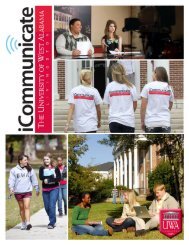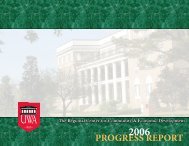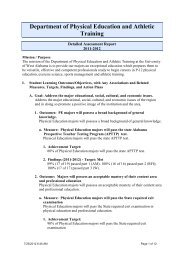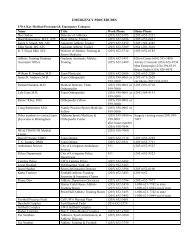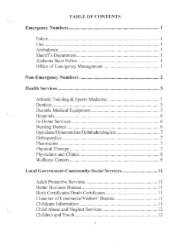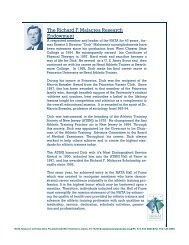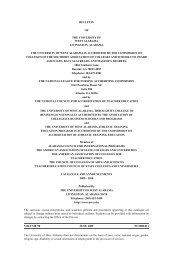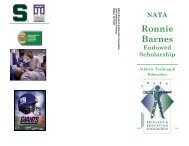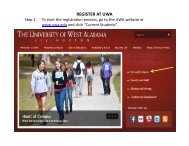table of contents - UWA Athletic Training & Sports Medicine Center
table of contents - UWA Athletic Training & Sports Medicine Center
table of contents - UWA Athletic Training & Sports Medicine Center
Create successful ePaper yourself
Turn your PDF publications into a flip-book with our unique Google optimized e-Paper software.
<strong>UWA</strong> Emergency Action PlanFootball/Soccer Emergency Procedures (Tiger Stadium)1. When a football player is injured on the playing field the head athletic trainer, assistantathletic trainer, or director <strong>of</strong> sports medicine, and the student athletic trainer on primaryfield watch go to the athlete to evaluate the problem. If the athlete is unconscious when theyarrive the closest person to the head <strong>of</strong> the athlete should hold cervical stabilization, whileone <strong>of</strong> the other athletic trainers performs a primary survey. On the sidelines, the athletictrainer with secondary injury management should be able to see one <strong>of</strong> the attending athletictrainers and watch for the signals for the emergency equipment. The signals for the c-collarand spine board are as follows: for the c-collar both hands clasped around the neck and forthe spine board take both hands with thumbs extended and point to the spine with them.Also, the athletic trainers should take the face mask removal tool out <strong>of</strong> the white trunkwhen they get the c-collar, to cut <strong>of</strong>f the face mask, if necessary.2. If the one <strong>of</strong> the staff athletic trainers believe the injury to be life threatening or a serioushead injury then they should send for the emergency equipment and the team physician.One <strong>of</strong> the athletic trainers should then proceed to the ambulance and direct them in to thescene (or go into Homer Field House or use cellular phone and enact the EMS from one <strong>of</strong>the phones if the ambulance happens to not be on the scene).3. While that is going on, the athletic trainer with emergency transportation should get theinsurance and emergency information from the field kit to take with them on the ambulance.The team physician should be with the injured athlete by this time and should be doing adiagnostic examination. Another athletic trainer will get the state vehicle and follow theambulance to the health care facility and report by phone any outcome to the senior staffathletic trainers. Make sure all equipment is gathered and returned when you return form thehealth care facility.Location <strong>of</strong> all phonesPhones for emergency actions are available for the following sports at the following locations inthe event that an onsite cellular phone is not accessible:1. If a cellular phone is available it can be used at any location on campus to enact theEMS by dialing 9112. Tiger Football/Soccer stadium: access to a phone is located within James P. Homerfield house on either the first or second floors: in the taping room (#116), equipmentroom (#113), secretary’s <strong>of</strong>fice (#221), and the athletic training facility (#216).76




